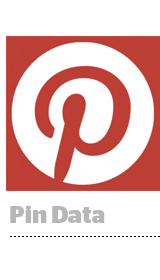 Pinterest has the best data among the social platforms that have yet to embrace ads in a big way.
Pinterest has the best data among the social platforms that have yet to embrace ads in a big way.
It’s often said the company, like Google, is inherently intent-based, exposing potential future purchases each time a user “pins” the wrap skirt or maple countertop her heart desires.
Today Pinterest is creating more granularity around user interactions with the rollout of new reporting capabilities showing pins, repins, shares and other interactions with a business’s presence on the service.
The offering is the company’s first global product rollout for advertisers (Promoted Pins, its paid media product, is still in a limited beta test), and is available in 31 languages to all marketers that convert to a business account. The point is to help business users, “partners” in Pinterest’s parlance, identify what’s resonating and use that information to support marketing initiatives.
Data available through the new interface include total reach for a business account’s pins, broken down by gender, device type, country or metro area when applicable. Aggregate actions such as total repins, clicks and shares are available, as is repin data for individual pins.
Over time Pinterest says it will offer more data on specific pins, and on interactions with the “pin it” buttons companies host on their own websites. It’s easy to see the implication for ads when the analytics dashboard can show reach and performance of organic vs. paid pins.
Additionally Pinterest is bucketing interests about a company’s audience on Pinterest. Advertisers can identify their audience’s most common interests – such as “succulents” and “glamping,” shown below – and what other businesses they follow.
“We’re dependent on these partners to bring the majority of content to the service,” said Pinterest product manager Jason Costa. “We want to provide businesses and partners with insights into how their content is performing. We’ve seen businesses make very direct changes to product strategy based on things they’re doing on Pinterest.”
For instance, Costa noted boutique men’s retailer Vineyard Vines restocked a belt that it had discontinued after repins of the garment exploded. And Lowe’s extended a “make your own doormat” product in-store after it achieved around 200,000 repins.
There’s more in the Pinterest blog post. The move comes five days after another heavily photo-driven social platform, Facebook-owned Instagram, rolled out its own analytics platform, presenting audience and interaction data for Instagram business accounts.
The new dashboard is an important precursor to Pinterest’s plans to monetize the site. Pinterest has said those plans do not yet include a private exchange-bidding platform, a la Facebook Exchange. Rather it sees its role in the programmatic ecosystem as a data provider, helping brands assess the impact of campaigns that run on its platform.
That could mean partnering with the likes of Datalogix and Nielsen Catalina Solutions, to attribute offline conversions back to media impressions on Pinterest. It may also create direct relationships with retailers’ point-of-sale systems, loyalty programs and branded credit cards. All of this, conceivably, could be fed into the centralized dashboard.














